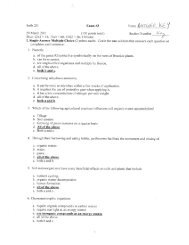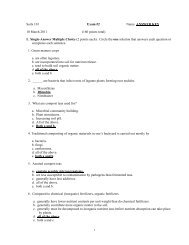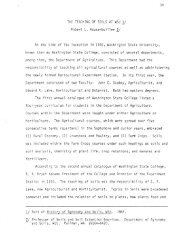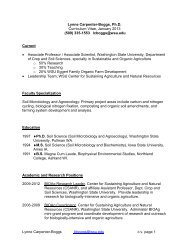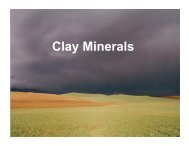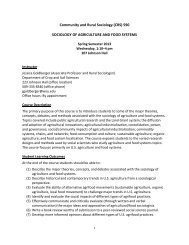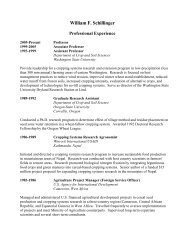2012 Dryland Field Day Abstracts - Dept. of Crop and Soil Sciences ...
2012 Dryland Field Day Abstracts - Dept. of Crop and Soil Sciences ...
2012 Dryland Field Day Abstracts - Dept. of Crop and Soil Sciences ...
You also want an ePaper? Increase the reach of your titles
YUMPU automatically turns print PDFs into web optimized ePapers that Google loves.
Page 60<br />
<strong>2012</strong> <strong>Field</strong> <strong>Day</strong> <strong>Abstracts</strong>: Highlights <strong>of</strong> Research Progress<br />
August 10 <strong>and</strong> 18) had nice st<strong>and</strong>s going into the winter. Sun <strong>and</strong> growing degree days were lacking in the spring, yet canola yield<br />
was excellent. With all seeding dates, there was no advantage to increasing seed rate with regard to yield. When averaged over<br />
the 2010 seeding dates, yield was 1,650 lbs/A at 4 lbs/A, <strong>and</strong> 1,580 lbs/A at the higher seeding rate. Canola yields for both August<br />
seeding dates were also similar – 1,605 lbs/A for August 10 <strong>and</strong> 1,620 lbs/A for August 18.<br />
We believe the optimum time <strong>of</strong> planting is when “Mother Nature” tells you to – generally from August 5 to August 20-25 when<br />
cool weather is forecast. The past two years, growers have actually stopped wheat <strong>and</strong> canola harvest to plant their winter<br />
canola. Five new growers planted winter canola in Okanogan <strong>and</strong> Douglas Counties in August 2011. Winter canola acreage has<br />
increased from 15 acres to almost 2,500 acres since 2007. One member <strong>of</strong> the CCT planted 35 acres <strong>of</strong> winter canola in 2011. We<br />
have worked with the CCT to assist them in establishing an Agriculture Team focusing on canola production. The team has 45<br />
acres ready to plant in the fall <strong>of</strong> <strong>2012</strong>. A grower in Okanogan County has contracted to plant an irrigated circle <strong>of</strong> spring canola<br />
for seed increase.<br />
Safflower Oilseed Production under Deficit Irrigation <strong>and</strong> Variable N Fertilization<br />
Hal Collins, Ashok Alva <strong>and</strong> Rick Boydston; USDA-ARS <strong>and</strong> WSU, Prosser<br />
Safflower is considered a low input <strong>and</strong> drought tolerant crop, but responds well to irrigation <strong>and</strong> fertilizer. In central WA,<br />
safflower may provide an oilseed crop option with lower water dem<strong>and</strong>s than some other broadleaf crops in irrigated cropping<br />
systems. Safflower is planted in the spring <strong>and</strong> reaches maturity in about 5 months in south-central Washington. Grain yield is<br />
about 3000 to 3500 lbs/acre with oil concentration <strong>of</strong> 35-40% depending upon variety. Our objectives are to determine 1) varietal<br />
responses <strong>of</strong> safflower to deficit irrigation <strong>and</strong> N fertilization under center pivot irrigation <strong>and</strong> 2) oil production <strong>and</strong> quality under<br />
deficit irrigation <strong>and</strong> N fertilization.<br />
We conducted research from 2007-2011 at the USDA-ARS Integrated <strong>Crop</strong>ping Systems Research <strong>Field</strong> Station near Paterson, WA.<br />
Three safflower varieties (S345, CW99OL, <strong>and</strong> S334) were planted under center pivot irrigation. Irrigation treatments were 90 <strong>and</strong><br />
70% <strong>of</strong> ET with approximate in-season (May-September) applications <strong>of</strong> 30 <strong>and</strong> 23 inches <strong>of</strong> irrigation, respectively. Fertilizer<br />
treatments consisted <strong>of</strong> four split N application rates at approximately two week intervals for a total <strong>of</strong> 100 or 145 lbs N/acre.<br />
Safflower yields averaged 2770 lb/acre, <strong>and</strong> yields were significantly higher with 100 lb N/acre than 145 lb N/acre. Yields<br />
averaged over the four years <strong>of</strong> the study were not significantly different between 90 <strong>and</strong> 70% ET, suggesting a potential 4.7-7.5”<br />
water savings using a deficit irrigation strategy. Similarly, oil yield was higher under deficit irrigation, a reflection <strong>of</strong> higher yields<br />
<strong>and</strong> greater water use efficiency.<br />
As a result <strong>of</strong> this study, we will develop an Extension bulletin<br />
to aide growers who are interested in irrigated safflower<br />
production. Deficit irrigation scheduling <strong>and</strong> N fertilization<br />
recommendations are key components <strong>of</strong> the information we<br />
will provide, as well as the chemical composition <strong>of</strong> the oil<br />
that may provide an alternative value-based market for<br />
producers.<br />
Winter canola seeding rate<br />
study at Okanogan; 4 lbs/A<br />
(left) <strong>and</strong> 8 lbs/A (right).




